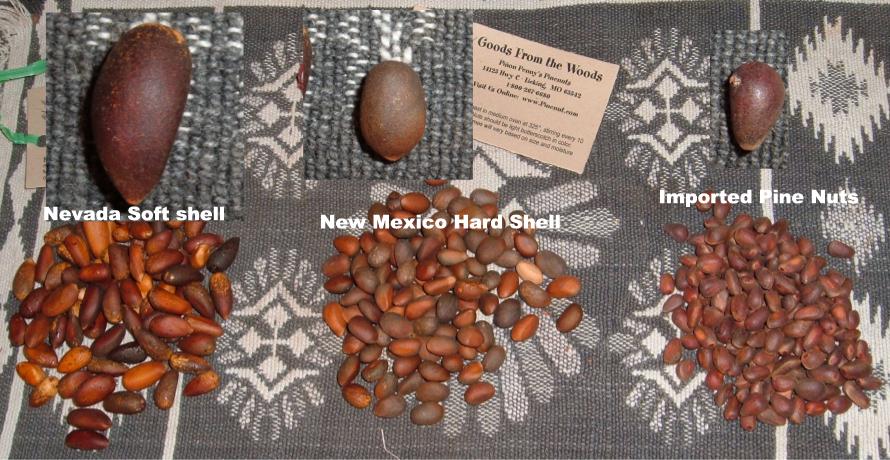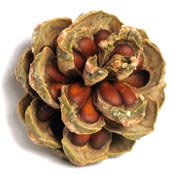Know your pine nuts!
PineNut.com has been the premiere site on the internet for pinenut information since 1998. We discovered that many people do not know much about American pine nuts, or even that these exist! Pinyon or Pinon Pine Nuts are a wild, native American food, known on the East Coast as Indian Nuts. There are many common misconceptions about these amazing nuts (some even note that they come from India!). Many food writers mistakenly assert that any pine nut can be called a pinon. But no, pinon pine nuts are uniquely American, with a great deal of difference from imported ones.

We adore their sweet, fruity nut flavor. Pinon Penny's Nuts have been cleaned extra well to remove all excess pitch. Nuts are rolled in vegetable oil to remove pitch. Not all harvesters clean the nuts this well, which is one reason you will find our Nevada Nuts Superior to others offered elsewhere. Additionally, our pickers work hard to get the largest, frestest nuts. Year after year, we hear "Pinon Penny, Thank you!!!" For the food values of Nevada Soft shelled pine nuts, see Pinus Monophylla Nutritional Information For Major Pine Nut Species.
FAMOUS New Mexico pinon pine nuts (Pinus edulis)
Buttery flavor, known as Indian Nuts on the East Coast, hand harvested, wild. These Pine Nuts are beyond belief, with their rich butter taste. The species is Pinus edulis and they are the most valuable pine nut in the world - Bar none!
New Mexico's Pinon nuts require a bit of patience. The shell is too hard to crack with your fingers. They are eaten roasted in-shell like sunflower seeds. The nut meat will be a buttery golden color, even raw. The color gets richer as the oils emerge from roasting. Roasting for this species is EASY, which is why we offer raw pinon!!
ITALIAN Stone pine (Pinus pinea)
Many tout the Pine nuts from Italy (pignolia, pinolia), however that species Pinus pinea is very common in the European market and grown throughout the Meditrainian region. The processing factors and distribution factors of Pinus pinea end up making it rather bland.
CHILGOZA pine nuts (Pinus gerardiana)
The seeds of Pinus gerardiana, a pine which occurs in Afghanistan and Pakistan where it is known as chilgoza or nioza, has been a traditional food of nomadic tribes. The large cones of this tree were collected by means of long, hooked poles. They were then gathered and stacked in heaps while still unripe and were roasted over an open fire. The resin in the cones would catch fire and the resultant heat would open the cones and release the seeds. The seeds of Pinus gerardiana are long and boat-shaped with one sharp end.
Pinus gerardiana seeds are preferred by the confectionery industry because they are easier to insert into cakes and sweets than are the blunt nuts of the piņon pines or Pinus pinea14 % protein, 51% fats, 21% carbohydrates
CHINESE or SIBERIAN pine nuts (Pinus sibirica)
Most of the nuts imported from China ("Chinese pine nuts") are of the Siberian pine variety (also called "cedar nuts"). Many people are attempting to pass the Siberian pine nuts off as New Mexico pinon nuts. Here are some ways to tell if someone is trying to pull the wool over your eyes:
- Siberian Nuts are much smaller, harder and have a more pointed end. These nuts have wonderful pine nut oil contet.
- The nut meat looks nothing like the nut meats of New Mexican or Nevada Pine nuts, they have very tiny, delicate nut meats.
- There will be a slight ridge on the edge of the nut in shell.
- They are not as "round and flat" as pinons but more pointed.
- Many of the wonderful oils in the Siberian nut evaporate within seconds of cracking. The best way to obtain the true flavor of a Siberian kernel is to buy it in the shell when it has been properly harvested!! Very few pine nuts are harvested or processed with quality in mind.
IMPORTANT NOTE: because of their high oil content, Chinese (or Siberian, or Korean) pine nuts require constant refrigeration to keep fresh. This is rarely done along the distribution chain, so the quality of the end product is often questionable.
Know your vendors!
Be careful with your purchasing of pinons. Some vendors buy cheap imported Chinese/Siberian nuts and mix them with the Pinus edulis (Hard shell pinon Pine nuts). Another concern you may have is nuts harvested from the ground. Most online sellers are not pickers. They don't know where the nuts have been, how they were harvested or when. I have seen outragous claims made about harvests in an attempt to make the vender's products "special". You might ask pinon vendors, when and where they purchased their nuts, who harvested them, were they stored in health certified production facilty. Were they processed in a clean licensed facilty? Ours are. Our storage area is cleaned regularly with natural and organic oils to repell vermin. Our facilty has special air circulation and nuts are stored between 42 and 38 degrees at all times.




